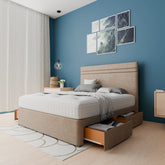Choosing the right bed size for your child is more than just a matter of measurements. It's about making sure they're comfortable, protected, and healthy overall as they mature. Every bed size has its benefits that are appropriate for a particular stage of childhood, ranging from the small space of a cot to the roominess of a twin or full bed.
By being aware of these choices, parents can design the ideal sleeping environment for their child. We'll go over different bed sizes and how well they work for various age groups in this guide to assist you in choosing a size that will provide your child with a good night's sleep and calm dreams.
When choosing the right bed size for your child, consider factors such as their age, size, sleeping habits, available space in the bedroom, and any future needs or preferences. Additionally, prioritize safety by selecting beds with sturdy construction and adhering to safety guidelines, especially for younger children.
How do you choose the right bed size for your child?
Choosing the right bed size for your child is essential for their comfort and safety. Here's a detailed guide to help you make the right decision:
Crib (Standard Size):
- Suitable for infants and toddlers up to around 2-3 years old.
- Dimensions typically around 28 inches wide and 52 inches long.
- Provides a cozy and secure sleeping environment for babies.
- Ensure that the crib meets safety standards to prevent accidents.
Toddler Bed:
- Transition bed for toddlers who have outgrown their cribs but may not be ready for a full-sized bed.
- Generally fits crib-sized mattresses.
- Offers a low-to-the-ground design for easy access and safety rails to prevent falls.
- Ideal for children aged 2-5 years old.
Twin Bed:
- Commonly referred to as a single bed.
- Dimensions approximately 38 inches wide and 75 inches long.
- Suitable for children of all ages, especially older toddlers and school-aged kids.
- Space-saving option for smaller bedrooms or shared rooms.
- Can accommodate one child comfortably.
Twin XL Bed:
- Similar to a twin bed but with extra length.
- Dimensions around 38 inches wide and 80 inches long.
- Ideal for taller children or teenagers who have outgrown a standard twin bed.
- Provides more legroom while still fitting into smaller spaces.
Full Bed (Double Bed):
- More comprehensive than a twin bed, offering more sleeping space.
- Dimensions approximately 54 inches wide and 75 inches long.
- Suitable for older children or teenagers who desire more space to stretch out.
- Can accommodate one child comfortably or two more minor children if needed.
Bunk Bed:
- It consists of two beds stacked on top of each other and connected by a ladder or stairs.
- Available in twin or full sizes.
- Ideal for siblings sharing a room or for maximizing space in a smaller bedroom.
- Ensure the top bunk has safety rails to prevent falls.
Can I use a full-sized bed for my child, or is it too big?
Using a full-sized bed for your child can be a suitable option, depending on several factors, such as the child's age, size, and personal preferences, as well as the available space in the bedroom.
Here are some considerations to help you decide if a full-sized bed is appropriate for your child:
Age and Size: Full-sized beds are more extensive than twin beds, so they may be more suitable for older children, teenagers, or those who are taller and need more space to stretch out comfortably.
Comfort: If your child tends to move around a lot during sleep or feels cramped in a smaller bed, a full-sized bed can provide ample space for movement and better sleep quality.
Room Size: Consider the size of your child's bedroom. If space allows, a full-sized bed can provide a comfortable sleeping area without overwhelming the room. However, in smaller bedrooms, a full-sized bed may take up too much space, making the room feel crowded.
Future Use: Investing in a full-sized bed for your child can be a long-term solution. They can continue using it through their teenage years and even into adulthood, saving them the hassle and expense of upgrading to a larger bed as they grow older.
Safety: Ensure that your child can safely get in and out of the bed, especially if it's higher off the ground than their previous bed. Consider using bed rails if needed, especially for younger children, to prevent falls.
Final Words
The size of their bed directly impacts your child's comfort, safety, and general quality of sleep, so make the proper choice. You may be confident that your child will have peaceful sleep cycles and wake up feeling refreshed and prepared for the day when they have the appropriate bed size.
Also Read: Orthopaedic Mattress vs Memory Foam - The Expert Guide
Are you looking for the right bed for your child? You've come to the right place. Here at The Bed Crafters, we provide the best beds for children, giving them a peaceful and comfortable sleep.
FAQs
What age is appropriate to transition my child from a crib to a toddler bed?
Most children transition from a crib to a toddler bed between the ages of 2 and 3, but readiness varies for each child. Look for signs of climbing out of the crib or expressing discomfort in confined spaces.
How do I know if my child needs a larger bed size?
Signs that your child may need a larger bed include frequent complaints of being uncomfortable, difficulty falling asleep, or physical signs of outgrowing their current bed, such as limbs hanging off the sides.
Is it safe for my child to sleep in a bunk bed?
Bunk beds can be safe for children if they are correctly constructed and equipped with safety rails on the top bunk. Ensure that children using bunk beds are old enough to navigate the ladder or stairs and follow safety guidelines safely.
What if I have limited space in my child's room?
Consider space-saving options like bunk beds, loft beds, or trundle beds, which maximize floor space while still providing comfortable sleeping arrangements for children.
How do I ensure my child's bed is safe?
Choose beds that meet safety standards, ensure proper assembly and installation, and regularly inspect the bed for any signs of wear or damage. Use safety rails for younger children and teach older children about safe sleeping practices.
What if my child prefers a different bed size than what's recommended for their age?
Ultimately, the best bed size for your child is one that meets their individual preferences, comfort needs, and sleeping habits. Consider their input and accommodate their preferences within reason while still prioritizing safety and practicality.






